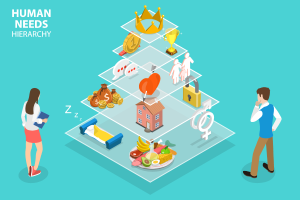Continued from Part 4
Maslow’s Tech Method Steps 3 & 4
Step 3 – Love & Belonging, Allowing Effective Group Dynamics and Cooperation
The third level of our tech pyramid, or set of ingredients for the best security recipe, is what Maslow called ‘Love and Belonging.’ This is actually not as abstract as it initially sounds. Now that our physical security and personal safety are in place, it is time to consider how that system fosters an effective working environment for groups of people, which is central to any organization. As noted in the beginning of this article, you don’t have to be working in an office to be aware of the amount of ‘remote-work’ that has been installed as a response to the COVID pandemic.[1] Social distancing requires that we remain apart, but we still have to work together. Some of the more agile organizations were already familiar with the secure networks, virtual desktops, electronic business communication platforms, and video conference tools necessary to maintain the same flow that a physical office provides.
However, as employees begin to return to the office and hybrid models begin to emerge, what does that look like in terms of access control and security technologies? While contactless technology, as found on the preceding level, has risen in importance due to public health concerns, here we find the other features that allow for easy and efficient group dynamics, such as the ‘seamless’ and ‘frictionless’ technology of mobile credentials as a method of access control.[2] This is especially important as policies and procedures will change to adapt to changing circumstances. Effective communication will be foundational not only to good group dynamics, but a holistic security system as well if you want to account for the human element.[3] Like any good dish, this ingredient cannot stand on its own, but is still a critical aspect of any complete security or access control system. As more of our own devices are brought to use in this mix of working-from-home with limited or controlled use of public spaces, safe and seamless group systems are not only a matter of security, but of balancing work with a home life.[4]
Step 4 – Esteem, The Flourishment of the Individual
 Now that you have your group in working order, the next item on the menu is to make sure that the discrete units that make up the overall recipe don’t get lost in the mix, the individual. As briefly mentioned earlier, the potential ‘death of the office’ is a hot topic of discussion. It also makes an excellent case study for working through this level of Maslow’s hierarchy. One of the central themes of the debate revolves around push and pull of the person as they relate to the larger organization. Many fear losing the office could mean losing creative group cohesion as well as the further alienation of the employee from their place of work, while others see this moment as an opportunity to redirect energy and power back to the hands of the individual as the prime locus for growth. Remote work is one such battleground.
Now that you have your group in working order, the next item on the menu is to make sure that the discrete units that make up the overall recipe don’t get lost in the mix, the individual. As briefly mentioned earlier, the potential ‘death of the office’ is a hot topic of discussion. It also makes an excellent case study for working through this level of Maslow’s hierarchy. One of the central themes of the debate revolves around push and pull of the person as they relate to the larger organization. Many fear losing the office could mean losing creative group cohesion as well as the further alienation of the employee from their place of work, while others see this moment as an opportunity to redirect energy and power back to the hands of the individual as the prime locus for growth. Remote work is one such battleground.
Mance provides a historical overview of the modern office, how it transitioned from rows of desks to closed cubicles to the “open-plan office,” and how those epochs have structured the “existential questions” of the workers who have lived in them. Many feel like cogs in a machine, though admittedly one that is increasingly digital. The more the office ‘opened up,’ ironically the less interaction there was as people were pushed toward electronic communication. Again, however, “Coronavirus has changed the equation.” Now the line between office and home are blurred beyond recognition, there is a real push by both employees and management to use this time to find a balance that works for all parties involved.[5]
Beyond vague calls for an environment conducive to the growth of the individual, one way to conceptualize that in practice will be the experience of the user as the interact with the technology. An interface that is easy to master is critical to effective security policies and communication between users and management.[6] Moreover, with the proliferation of consumer-level software, apps, and online resources that are becoming more cost-competitive with their enterprise-level counterparts, integration of these tools in secure environments is a lynchpin to a custom user experience unique to each individual while still providing protection to the group as a whole.[7] For example, with the need for distancing and socially ‘contactless’ interactions raised to the highest priority, high-end technologies like biometrics are being seen as a means of providing a more seamless user experience to accomplish those goals.[8] Therefore, Walton predicts that all of the contactless solutions and technologies will ultimately be determined by the user experience they provide. This level being particularly necessary for the retail industry, one that is having the most difficulty finding the right balance between safe, touchless procedures and an environment that encourages sales. However, this only makes having a robust methodology for comparing services all the more important because, “not all forms of contactless retail are created equal. Knowing when to use what and what options to believe are safe relative to others is not easy, despite what is presented in the media.”[9]
Continued in Part 6
Endnotes
[1] See, Bienvenu, Emma Rose. “7 Predictions for a Post-Coronavirus World.” Marker Medium.com. April 13, 2020. https://marker.medium.com/7-predictions-for-a-post-coronavirus-world-aaac052c8514 (accessed April 17, 2020).
[2] Lydic, Robert. “Safer Campus Security with Touchless Access Control, Contactless Credentials.” CR80 News. May 15, 2020. https://www.cr80news.com/news-item/safer-campus-security-with-touchless-access-control-contactless-credentials/?pad.tz.net (accessed June 2, 2020).
[3] Whitehead, Mark. “How Security Testing Could Change After COVID-19.” Tech Target. May 2020. https://searchsecurity.techtarget.com/feature/How-security-testing-could-change-after-COVID-19 (accessed June 3, 2020).
[4] Rozen, Lior. “COVID-19 Related Cyber Security Adjustments.” Security Boulevard. May 19, 2020. https://securityboulevard.com/2020/05/covid-19-related-cyber-security-adjustments/ (accessed June 4, 2020).
[5] Mance, Henry. “The Rise and Fall of the Office.” Financial Times. May 15, 2020. https://www.ft.com/content/f43b8212-950a-11ea-af4b-499244625ac4 (accessed May 27, 2020).
[6] Ritchey, Diane. “How COVID-19 has Transformed InfoSec.” Security Magazine. June 1, 2020. https://www.securitymagazine.com/articles/92488-how-covid-19-has-transformed-infosec (accessed June 4, 2020).
[7] Fodrey, Brian. “6 Factors Impacting Information Security and Privacy During the COVID-19 Crisis.” Campus Technology. May 28, 2020. https://campustechnology.com/articles/2020/05/28/6-factors-impacting-information-security-and-privacy-during-the-covid-19-crisis.aspx (accessed June 4, 2020).
[8] Roig, Michel. “Contactless Comes of Age: How Biometrics Is Taking Cards to the Next Level.” Payments Journal. April 30, 2020. https://www.paymentsjournal.com/contactless-comes-of-age-how-biometrics-is-taking-cards-to-the-next-level/ (accessed May 28, 2020).
[9] Walton, Chris. “‘Contactless’ Is Retail’s New Must-Have Safe Word, But Executing It Is Easier Said Than Done.” Forbes. May 15, 2020. https://www.forbes.com/sites/christopherwalton/2020/05/15/contactless-is-retails-new-must-have-safe-word-but-knowing-how-best-to-use-it-is-easier-said-than-done/#4c18bf6f4758 (accessed May 27, 2020).
